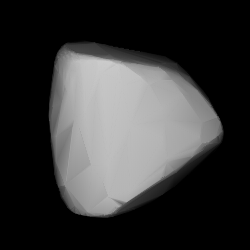103 Hera is a moderately large main-belt asteroid with an orbital period of 4.44 years. It was discovered by Canadian-American astronomer James Craig Watson on September 7, 1868, and named after Hera, queen and fifth in power of the Olympian gods in Greek mythology. This is a stony S-type asteroid with a silicate surface composition.
Photometric observations made in 2010 at the Organ Mesa Observatory at Las Cruces, New Mexico, and the Hunters Hill Observatory at Ngunnawal, Australian Capital Territory, give a synodic rotation period of 23.740±0.001 h. The bimodal light curve shows a maximum brightness variation of 0.45 ± 0.03 in magnitude.
Measurements made with the IRAS observatory give a diameter of 91.58±4.14 km and a geometric albedo of 0.19±0.02. By comparison, the MIPS photometer on the Spitzer Space Telescope gives a diameter of 88.30±8.51 km and a geometric albedo of 0.20±0.04. When the asteroid was observed occulting a star, the chords showed a diameter of 89.1±1.1 km.
References
- ^ JPL Small-Body Database Browser, JPL, retrieved 30 October 2020
- "Hera". Oxford English Dictionary (Online ed.). Oxford University Press. (Subscription or participating institution membership required.)
- ^ Yeomans, Donald K., "103 Hera", JPL Small-Body Database Browser, NASA Jet Propulsion Laboratory, retrieved 12 May 2016.
- ^ Pilcher, Frederick (January 2011), "Rotation Period Determination for 103 Hera", The Minor Planet Bulletin, 38 (1): 32, Bibcode:2011MPBu...38...32P.
- ^ DeMeo, Francesca E.; et al. (2011), "An extension of the Bus asteroid taxonomy into the near-infrared" (PDF), Icarus, 202 (1): 160–180, Bibcode:2009Icar..202..160D, doi:10.1016/j.icarus.2009.02.005, archived from the original (PDF) on 17 March 2014, retrieved 22 March 2013. See appendix A.
- "Numbered Minor Planets 1–5000", Discovery Circumstances, IAU Minor Planet center, retrieved 7 April 2013.
- Ryan, Erin Lee; et al. (April 2012), "The Kilometer-Sized Main Belt Asteroid Population as Revealed by Spitzer", arXiv:1204.1116
External links
- 103 Hera at AstDyS-2, Asteroids—Dynamic Site
- 103 Hera at the JPL Small-Body Database

| Minor planets navigator | |
|---|---|
| Small Solar System bodies | |||||||
|---|---|---|---|---|---|---|---|
| Minor planets |
| ||||||
| Comets | |||||||
| Other | |||||||
This article about an S-type asteroid native to the asteroid belt is a stub. You can help Misplaced Pages by expanding it. |
